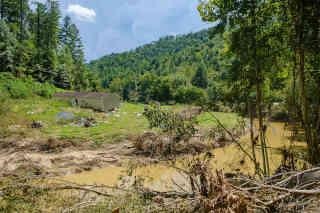By Aimee Nielson
Mother Nature dealt heavy blows to Kentucky cattle producers this year. Early summer drought caused hay shortages in the west and late July flooding turned Eastern Kentucky pastures into rivers. The high waters wiped out fences and left pasture areas covered in mud and silt that still pose risks to livestock.
“The first question livestock owners had to ask was, ‘What has washed into my pasture?’ They had to carefully walk the area in case they encountered debris, especially hazardous material such as lead batteries, chemicals stored in containers that were damaged, or other foreign objects that cattle may ingest,” said Jeff Lehmkuhler,

beef specialist. “I’ve seen an ATV wedged up high in a tree, parts of destroyed homes in low areas leaving insulation in fields, and large propane tanks washed up into fields. Landowners need to take caution to protect themselves when cleaning up fields. Debris with nails or sharp, exposed edges can cause trauma, especially to livestock hooves.”
Floodwaters created washed-out areas in many tilled river bottoms. Other debris left behind included a lot of plastic, which poses a choking hazard to cattle. Many producers are still repairing miles of damaged or missing fence. Farmers who still need help with fencing supplies should contact their county extension agent for resources.
Beyond pasture woes, Eastern Kentucky producers need to make sure they have a clean water supply. Lehmkuhler warned that water could have anything in it, including harmful chemicals from pesticides, herbicides, fuel and oil from flooded stranded cars and other poisonous material.
“Big floods often break down catch basins for companies and industries and flow right into the creeks,” he said. “Floodwaters can break down and overwhelm wastewater plants leading to spills into the surface water. Testing the water is difficult because the water’s rapid movement and volume will dynamically change its composition. Be aware of what businesses and ag enterprises are located upstream.”
Another post-flooding concern is blackleg, a disease caused by bacteria that results in rapid death in unvaccinated cattle. UK ruminant veterinarian Michelle Arnold said producers should avoid feeding any feed left in fields, such as hay, due to the high risk of clostridiales from mud.
“Vaccinate calves against blackleg as soon as possible,” she said. “Maternal antibodies from colostrum are only protective for two to three months at best, so vaccination is necessary to protect older calves. Most blackleg vaccines require two doses, a primary and a booster, for complete protection.”
Producers should survey pastures and dispose of potentially dangerous things, like fish and other animals that died and got stranded, which are a potential source of botulism.
Given all the potential issues, Eastern Kentucky farmers may have a temptation to let cattle begin to graze new grass.
“Don’t start grazing too soon,” Lehmkuhler said. “Wait for rains to ‘clean’ any standing forage that may be in the fields. Many have excessive silt deposited on forage standing and may need some help to remove sand, gravel and to fix washouts. These fields will likely need to be replanted in September to get a good stand next spring. Fields with limited silting should be allowed to drain so livestock traffic doesn’t compact the soil and impact future production.”
Specialists recommend taking photos of all pasture damage.
“Be sure to ask your insurance company about your coverage,” Lehmkuhler said. “Ask what they need for your claim and take photos before you attempt to fix issues. Walk the field with the adjuster, if possible, to make sure they see everything.”
Drought in Western Kentucky, mostly during early summer, caused a pasture and hay shortage.
“When pastures get short during drought conditions, cattle may consume noxious weeds that they usually avoid, such as perilla mind,” said Kevin Laurent, agricultural extension specialist at the UK Research and Education Center in Princeton.
Laurent said it’s tempting to let cattle graze short grass as it starts to grow, but that’s not the best long-term strategy.
“It’s human nature to let cows graze for anything they can find, but what usually happens is we hammer our forage base into the ground and that increases recovery time and opens a canopy for weeds down the road,” he said. “Keeping cattle in the worst paddock is a better strategy.”
Laurent said feeding stored hay to the cattle in the paddock allows the pasture to recover in the other areas, without the stress of grazing. He said that strategy also allows cattle to fertilize the poorer paddock.
Source : uky.edu